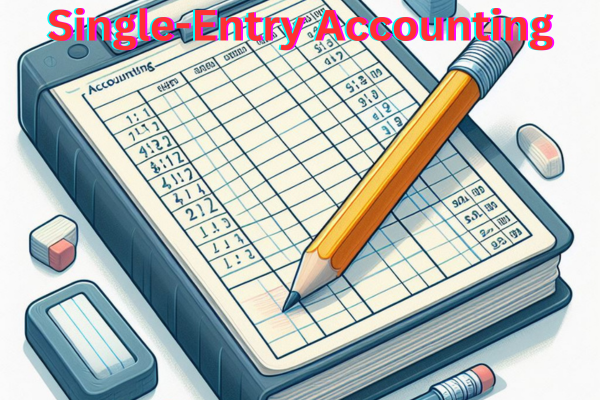Contents
Introduction of Single-Entry Accounting
In the complicated world of bookkeeping, two wonderful structures reign supreme: single-entry and double-entry. While double entry enjoys a well-merited popularity for its intricacy and accuracy, single entry remains a potential choice for small organizations and freelancers in search of a less complicated strategy for record-keeping.

However, perception of its nuances and obstacles is fundamental for knowledgeable decision-making.
What is Single-Entry Accounting?
Imagine a monetary diary the place where every transaction is recorded once, detailing the amount, date, and a quick description. That’s the essence of single-entry accounting. Unlike its double-entry counterpart, which archives every transaction twice (a debit and a credit), single entry focuses on a single entry for every earnings or expense. This method streamlines bookkeeping, making it reachable to persons with minimal accounting knowledge.
How Does it Work?
The cornerstone of single-entry is the money book, a chronological document of all economic transactions. Each entry normally includes:
- Date: When the transaction occurred.
- Description: A quick clarification of what came about (e.g., “Sale of 10 widgets”).
- Amount: The financial fee of the transaction, classified as earnings (money received) or cost (money spent).
- Balance: The up-to-date money on hand after accounting for the transaction.
Additional information like money owed payable and receivable may also additionally be used to music wonderful money owed and credits. However, the core focal point stays on monitoring money glide via the money book.
Advantages of Single-Entry Accounting
- Simplicity:
Single entry is inherently user-friendly, requiring minimal accounting expertise. This makes it best for small companies and men and women with restricted bookkeeping experience.
- Timesaving:
With fewer entries to manage, a single entry simplifies bookkeeping and saves treasured time. This allows companies to centre of attention on core operations alternatively rather than getting bogged down in accounting complexities.
- Cost-effectiveness:
Single entry requires much fewer software programs and assets in contrast to double entry, mainly to decrease operational costs. This can be a big benefit for startups and solopreneurs.
- Cash-flow focus:
Single entry’s emphasis on the money e-book naturally directs interest toward money flow, a necessary indicator for commercial enterprise health. This can assist agencies make knowledgeable monetary choices and keep away from money shortages.
Limitations of Single-Entry Accounting
- Limited insights:
Single entry solely affords a one-dimensional view of finances, making it challenging to analyze profitability, music assets, or generate correct monetary statements. This lack of elements can avert informed decision-making and restrict admission to financing.
- Risk of errors:
With simply one entry per transaction, mistakes can without difficulty go disregarded and lead to inaccurate monetary reports. This can have serious consequences, along with tax penalties and reputational damage.
- Scalability issues:
As agencies grow, the barriers to single entry become increasingly more apparent. Managing complicated monetary transactions and producing complete economic reviews turns into challenging.
- Lack of compliance:
Some guidelines can also require double-entry bookkeeping for tax functions or auditing. Transitioning from single entry to double entry later can be time-consuming and expensive.
Is Single-Entry Accounting Right for You?
Whether single entry is the proper suit for your commercial enterprise relies upon various factors
- Size and complexity of your business:
For small groups with confined monetary transactions, single entry can be a workable and least expensive option.
- Accounting expertise:
If you lack vast accounting knowledge, a single entry’s simplicity may also be appealing. However, think about looking for expert instruction to ensure accuracy and compliance.
- Financial reporting needs:
If you want state-of-the-art monetary reviews for investors, lenders, or regulatory purposes, double entry will be necessary.
- Growth potential:
If you assume substantial growth, single-entry obstacles can also abate future scalability and compliance.
Making an Informed Choice
While single entry affords a simple strategy to bookkeeping, it is quintessential to recognize its obstacles and plausible drawbacks. Carefully reflect on consideration of your commercial enterprise needs, accounting expertise, and future increase plans earlier than identifying the first-class system. Consult with a certified accountant or economic guide to achieve insights and make a knowledgeable decision.
By grasping the nuances of single-entry accounting, you can make a knowledgeable selection and leverage its advantages whilst mitigating its limitations. Remember, the proper bookkeeping device paves the way for monetary clarity, knowledgeable decision-making, and a sustainable boom for your business.
It’s About Time for You To learn How to Make $10,000+ Per Month in 90 Days or Even Less! Click here!!
THE LAST EXCEL COURSE YOU WILL EVER NEED! The Complete Excel, AI, and Data Science Mega Bundle! GRAB YOUR COPY NOW.

Leave a Reply